Related Research Articles
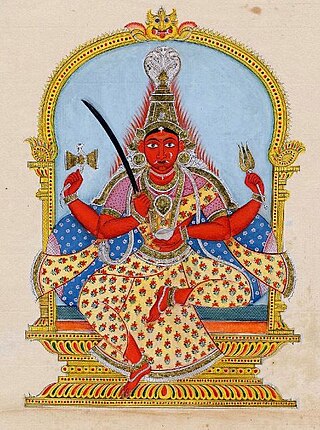
Mariamman, often abbreviated to Amman, is a Hindu goddess of weather, predominantly venerated in the rural areas of South India. Her festivals are held during the late summer/early autumn season of Ādi throughout Tamil Nadu and the Deccan region, the largest being the Ādi Thiruviḻa. Her worship mainly focuses on bringing rains and curing diseases like cholera, smallpox, and chicken pox. Mariamman is worshipped in accordance with local traditions such as Pidari or the Gramadevatai. She is considered as a guardian deity by many South Indian village-dwellers.
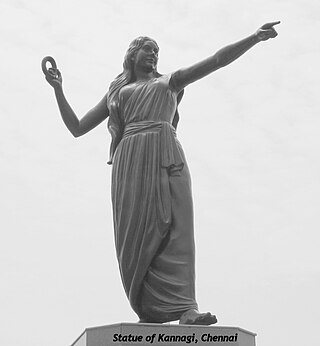
Kannagi, sometimes spelled Kannaki, is a legendary Tamil woman who forms the central character of the Tamil epic Cilappatikaram. Kannagi is described as a chaste woman who stays with her husband despite his adultery, their attempt to rebuild their marriage after her unrepentant husband had lost everything, how he is framed then punished without the due checks and processes of justice. Kannagi proves and protests the injustice, then curses the king and city of Madurai leading to the death of the unjust Pandyan King of Madurai, who had wrongfully put her husband Kovalan to death. The society that had made her suffer, suffers in retribution as the city Madurai is burnt to the ground because of her curse. In Tamil folklore, Kannagi has been deified as the symbol – sometimes as goddess – of chastity, with sculptures or reliefs in Hindu temples iconographically reminding the visitor of her breaking her anklet or tearing her bleeding breast and throwing it at the city.

A gramadevata is the tutelary deity of a given locality in Hinduism, primarily worshipped in the villages of India.

Hinduism is one of Sri Lanka's oldest religions, with temples dating back over 2,000 years. As of 2011, Hindus made up 12.6% of the Sri Lankan population. They are almost exclusively Tamils, except for small immigrant communities from India and Pakistan.

Bhadrakali is a Hindu goddess. She is considered to be the auspicious and fortunate form of Adi Shakti who protects the good, known as bhadra.

Koneswaram Temple of Trincomalee or Thirukonamalai Konesar Temple – The Temple of the Thousand Pillars and Dakshina-Then Kailasam is a classical-medieval Hindu temple complex in Trincomalee, a Hindu religious pilgrimage centre in Eastern Province, Sri Lanka. The most sacred of the Pancha Ishwarams of Sri Lanka, it was built significantly during the ancient period on top of Konesar Malai, a promontory overlooking Trincomalee District, Gokarna bay and the Indian Ocean. The monument contains its main shrine to Shiva in the form Kona-Ishvara, shortened to Konesar.
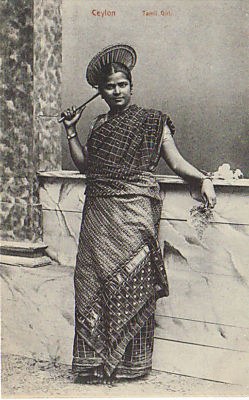
Sri Lankan Tamils, also known as Ceylon Tamils or Eelam Tamils, are Tamils native to the South Asian island state of Sri Lanka. Today, they constitute a majority in the Northern Province, form the plurality in the Eastern Province and are in the minority throughout the rest of the country. 70% of Sri Lankan Tamils in Sri Lanka live in the Northern and Eastern provinces.

Arumuka Navalar was a Sri Lankan Shaivite Tamil language scholar and a religious reformer who was central in reviving native Hindu Tamil traditions in Sri Lanka and India.
Negombo Tamils or Puttalam Tamils are the Tamil speaking ethnic Karavas who live in the western Gampaha and Puttalam districts of Sri Lanka. They are distinguished from other Tamils from the island nation by their unique dialects, one of which is known as Negombo Tamil dialect. Other sub categories of native Tamils of Sri Lanka are Jaffna Tamils or Northern Tamils and Batticalao Tamils or Eastern Tamils from the traditional Tamil dominant North and East of the Island nation. Negombo is a principal coastal city in the Gampaha District and Puttalam is also the principal city within the neighbouring Puttalam District.

Munneswaram temple is an important regional Hindu temple complex in Sri Lanka. It has been in existence at least since 1000 CE although myths surrounding the temple associate it with the popular Indian epic Ramayana, and its legendary hero-king Rama. The temple is one of the ancient Pancha Ishwarams dedicated to Shiva in the region.

Tamil mythology refers to the folklore and traditions that are a part of the wider Dravidian pantheon, originating from the Tamil people. This body of mythology is a fusion of elements from Dravidian culture and the parent Indus Valley culture, both of which have been syncretised with mainstream Hinduism.

Pungudutivu or Pungai Idu Tivu is a small island composed of number villages that is just west of the Jaffna Peninsula in Sri Lankan Tamil dominated Northern Province. It is divided into 12 wards internally, each corresponding a major settlement.
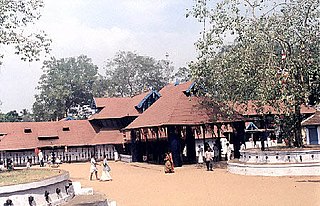
Sree Kurumba Bhagavati Temple is a Hindu temple at Kodungallur, Thrissur District, Kerala state, India. It is dedicated to the goddess Bhadrakali, a form of Mahakali or simply Durga or Aadi Parashakthi worshipped and significantly revered in Kerala. The goddess is known also by the names "Sri Kurumba"". This temple is the head of 64 Bhadrakali temples in Kerala. This Mahakali temple is one of the oldest functioning temples in India. This is attested by numerous Tamil poems and inscriptions of different times. The goddess of the temple represents the goddess in her fierce ('ugra') form, facing North, featuring eight hands with various attributes. One is holding the head of the demon king Daruka, another a sickle-shaped sword, next an anklet, another a bell, among others. Routine worship at the temple every day at 03:00 and ends at 21:00 local time.

Ati Konanayakar or Aathi Koneswaram is a regionally important Hindu temple in Tampalakamam village in the Trincomalee District of Sri Lanka. The name of the temple in Tamil means the "temple of the original lord of Koneswaram". It is situated 24 kilometers (15 mi) from the port town of Trincomalee. The temple was constructed during the 17th century as a successor to the Koneswaram temple that was destroyed by Portuguese colonials in 1622.

Thambiluvil Kannaki Amman Kovil is one of the most significant Hindu temples in the Ampara District of Eastern Province, Sri Lanka. It is situated about 70 km south of Batticaloa town and 11 km south to Akkaraipattu. It is considered as one of the ancient temples of Mattakkalappu Desam made for Kannaki Amman, the heroine of the great Tamil epic Silappatikaram.
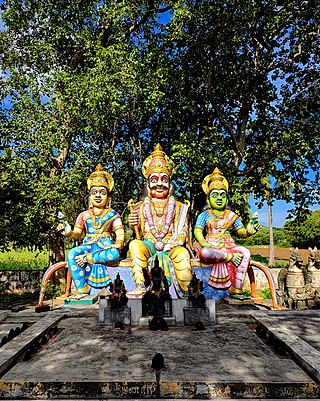
The early Dravidian religion constituted a non-Vedic form of Hinduism in that they were either historically or are at present Āgamic. The Agamas are non-Vedic in origin, and have been dated either as post-Vedic texts, or as pre-Vedic compositions. The Agamas are a collection of Tamil and Sanskrit scriptures chiefly constituting the methods of temple construction and creation of murti, worship means of deities, philosophical doctrines, meditative practices, attainment of sixfold desires and four kinds of yoga. The worship of tutelary deities and sacred flora and fauna in Hinduism is also recognized as a survival of the pre-Vedic Dravidian religion. Dravidian linguistic influence on early Vedic religion is evident; many of these features are already present in the oldest known Indo-Aryan language, the language of the Rigveda, which also includes over a dozen words borrowed from Dravidian. The linguistic evidence for Dravidian impact grows increasingly strong as one moves from the Samhitas down through the later Vedic works and into the classical post-Vedic literature. This represents an early religious and cultural fusion or synthesis between ancient Dravidians and Indo-Aryans that went on to influence Indian civilisation.

Nainativu Nagapooshani Amman Temple [Tamil: நயினாதீவு நாகபூசணி அம்மன் கோயில், romanized: Nayiṉātīvu Nākapūcaṇi Am'maṉ Kōyil - Meaning: Nainativu ; Nagapooshani ; Amman (Goddess)] is an ancient and historic Hindu temple located amidst the Palk Strait on the island of Nainativu, Sri Lanka. It is dedicated to Parvati who is known as Nagapooshani or Bhuvaneswari and her consort, Shiva who is named here as Nayinaar. The temple seems to have been mentioned in the Brahmanda Purana. The temple complex houses four gopurams ranging from 20–25 feet in height, to the tallest being the eastern Raja Raja Gopuram soaring at 108 feet high. The temple is a significant symbol for the Tamil people, and has been mentioned since antiquity in Tamil literature, such as Manimekalai and Kundalakesi. The present structure was built during 1720 to 1790 after the ancient structure was destroyed by the Portuguese in 1620. The temple attracts around 1000 visitors a day, and approximately 5000 visitors during festivals. The annual 16-day Mahostavam (Thiruvizha) festival celebrated during the Tamil month of Aani (June/July) - attracts over 100,000 pilgrims. There is an estimated 10,000 sculptures in this newly renovated temple.

Thirukkovil Temple is the most significant Hindu temple in Thirukkovil, Ampara District of Eastern Province, Sri Lanka. It is dedicated to Chitravelayudhar who was once the guardian deity of Mattakkalappu Desam and this temple enjoyed the honor of Desathukkovil of the Batticaloa region. Archaeological and historical evidences suggest that Cholan, Kotte and Kandyan kings maintained strong relations with this temple in the past.
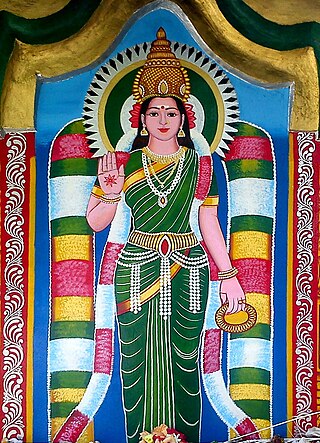
Kannaki Amman is the deified form of Kannagi, the heroine of the Tamil epic Cilappatikāram. She is primarily worshipped in Sri Lanka and Kerala, and in a minor way in few parts of Tamil Nadu. As a goddess of chastity, she is venerated by Indian Tamils and Malayalis, Sri Lankan Tamil Shaivites, and also by the Sinhalese Buddhists as Pattini Amma. In regional Hindu tradition, her tale is interpreted as the story of Durga demanding justice after the death of her husband, Kovalan, who is identified as a form of Shiva.

Karumariamman, also known as Karumari, is the Hindu goddess of smallpox, health and cure. She is also an aspect of the Hindu goddess Parvati and another form of the goddess Mariamman and Renuka. She is primarily worshipped in the villages of South India such as Thiruverkadu which is believed to be her abode.
References
- ↑ Civattampi, Kārttikēcu (1995). Sri Lankan Tamil society and politics. New Century Book House. p. 34. ISBN 9788123403953.
- 1 2 3 4 5 6 Ph.D. Ragupathy, Ponnampalam (1987). Early Settlements in Jaffna: An Archaeological Survey. University of Jaffna: Thillimalar Ragupathy. p. 217.
- ↑ Schalk, Peter (2013). "Part 3: Extension and Conclusions". Buddhism among Tamils in Tamilakam and Īlam. Vol. 33. University of Uppsala: Historia Religionum. p. 215. ISBN 978-91-554-8412-5.
- ↑ Kapferer, Bruce (2003-02-01). Beyond Rationalism: Rethinking Magic, Witchcraft and Sorcery. Berghahn Books. p. 156. ISBN 9780857458551.
- ↑ The Ceylon Antiquary and Literary Register. 1922. p. 12.
- ↑ McGilvray, Dennis B. (1974). Tamils and Moors: caste and matriclan structure in eastern Sri Lanka. University of Chicago. p. 205.
- ↑ Journal of the Royal Asiatic Society of Sri Lanka. Royal Asiatic Society of Sri Lanka. 1993. p. 137.
- ↑ Journal of the Institute of Asian Studies. Institute of Asian Studies. 1991. p. 7.
- ↑ Hudson, Dennis (1992). Jones, Kenneth W. (ed.). Religious controversy in British India: dialogues in South Asian languages. SUNY series in religious studies. Albany: State University of New York Press. ISBN 978-0-7914-0827-8.
- 1 2 3 Muttulingam, Thulasi (2016-12-19). "Politics between gods and worshippers in Jaffna's Hindu pantheon". Daily FT . Retrieved 2024-01-05.
